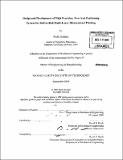Design and development of high precision five-axis positioning system for roll-to-roll multi-layer microcontact printing
Author(s)
Baldesi, Paolo
DownloadFull printable version (17.98Mb)
Other Contributors
Massachusetts Institute of Technology. Dept. of Mechanical Engineering.
Advisor
David E. Hardt.
Terms of use
Metadata
Show full item recordAbstract
Microcontact printing is based on the use of elastomeric stamps to transfer ink onto a substrate taking advantage of the self-assembly process. Features as small as 300nm can be easily printed over an extended area. The accuracy and the speed of the process make it suitable for many industrial applications in areas such as the manufacture of flexible displays and electronics. In 2008, a group of MIT mechanical engineering students built a prototype machine that demonstrated the advantages of the roll-to-roll paradigm in terms of high throughput, convenient material handling and conformal contact propagation. The prototype machine, although characterized by defects such as air trapping at very high speed, was able to print at speeds as high as 400 fpm with contact times of 7 ms, over an 8"x 8" substrate area. This year, an improved quality printing output and multilayer printing process were set as goals. To achieve the objectives, a device that could cast a flat stamp with little variance was designed and machined. (cont.) A high precision wrapping system was designed and fabricated. Finally, a high-precision positioning system was introduced to compensate for misalignment in the multi-layer printing process. This thesis describes the design of a five-axis high-precision positioning system to control the print roller along five degrees of freedom. Using flexures and micrometer heads as principal position control devices, the print roller can be positioned and oriented with high repeatability, 2.5lim accuracy, 2.5pm resolution, and the calibration showed that, in the worst case, the coupling among axes is limited to the 8%. Moreover, experimental results demonstrate that the new stamp casting method can accomplish ±16p.m flatness with thickness of 1194pm and that the innovative wrapping process ensures alignment of the backing plate with respect to the print roller with less than ±75V1m absolute misalignment. Consequently, using the upgraded roll-to-roll machine and the newly developed wrapping and stamp fabrication processes, deformation of the printed output is limited to an average of 3.8%. Finally, the multi-layer printing process was tested and a ±75V1m misalignment was achieved between two layers.
Description
Thesis (M. Eng.)--Massachusetts Institute of Technology, Dept. of Mechanical Engineering, 2009. Includes bibliographical references (p. 102-104).
Date issued
2009Department
Massachusetts Institute of Technology. Department of Mechanical EngineeringPublisher
Massachusetts Institute of Technology
Keywords
Mechanical Engineering.